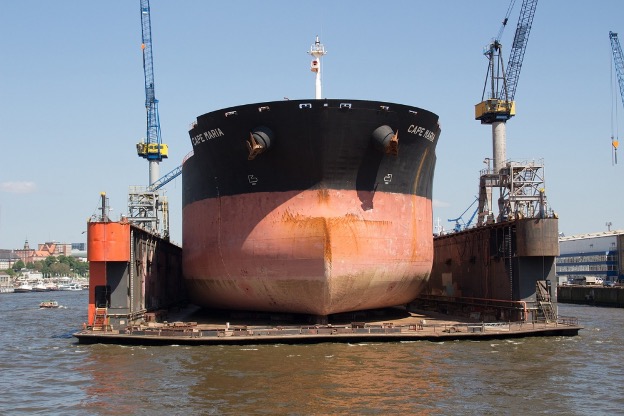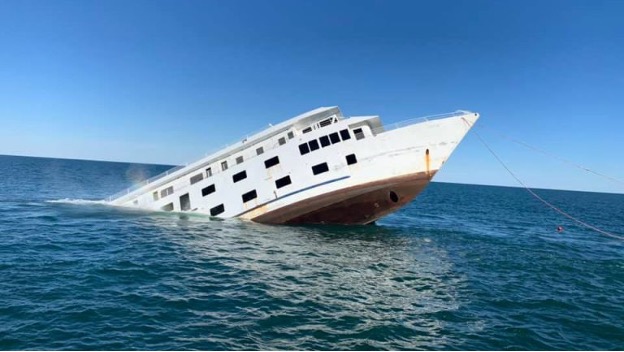Ships traveling through water create resistance to their forward motion. This resistance is called drag and is caused by the water molecules clinging to the ship’s hull and slowing it down. Frictional drag increases when the hull is fouled by marine growth.
Historically, it was believed that painting ships below the waterline with copper coating as a biocide would deter marine growth and help keep the hull clean. That copper coating which was red was responsible for the ship’s red tint.
The red painting below the waterline found on ships is therefore a result of the red tint given by a biocide used to deter marine growth on the parts of a ship that are constantly immersed in seawater.

Vessel painting is therefore a much more complex and important task than many people realize. Aside from simply decorating the vessel, painting is necessary for adding extra protection to the vessel’s underside. This aids in the prevention of marine fouling. This article takes a look at the scientific, operational, and economic reasons why a ship’s underwater hull has ended up with a distinctive red tint.
The Science Behind Painting Ships Red Below the Waterline.
Since the beginning of human exploration of the oceans, marine biofouling, – the undesirable growth of marine organisms such as bacteria, barnacles, and seaweeds on submerged surfaces, has been a prevalent and practical concern. It is a problem that affects maritime industries all around the world and has consequences in the form of economic as well as environmental costs.
The use of marine paints that include biocides has been the primary tactic that has been utilized in the fight against marine fouling.
Barnacles and other marine organisms that attach to ships can reduce speed and increase fuel consumption significantly. To prevent organisms from settling on the hull, ships are coated with special anti-fouling paint below the water line.
Sailing ships were traditionally coated with copper compounds that acted as a biocide, preventing marine organisms from adhering to the vessel’s hull. The ship’s red color was caused by the copper coating.
Metallic compounds that are toxic to marine life are now used in the shipping industry. The compounds slowly “leach” into the seawater, killing barnacles and other sea life attached to the ship. They however also have this nasty characteristic of persisting in the water for a long time, killing sea life, harming the environment, and entering the human food chain.
Organotin tributyltin (TBT), one of the most effective anti-fouling paints, was developed in the 1960s and was soon used by more than 70% of the international fleet as well as on yachts. It has been shown to cause oyster deformations and sex changes in whelks.
In 1989, the International Maritime Organization (IMO) acknowledged the negative environmental effects of organotin compounds. The Rio Conference on Environment and Development three years later called for a reduction in pollution caused by organotin compounds used in anti-fouling systems. The International Convention on the Control of Harmful Anti-fouling Systems on Ships was adopted in 2001 and will enter into force 12 months after 25 States ratify it, representing 25% of the world’s merchant shipping tonnage.
The Benefits of Painting Ships Red Below the Waterline.

It is self-evident in the twenty-first century that antifouling coatings can be mixed with any color and sometimes they do use other colors. So why do ships insist on wearing red? Of course, it’s a nautical tradition!
Another reason can be found in the contrast of the red hull to the seawater, which indicates if the cargo load is too heavy: The deeper a ship enters the water, the more cargo it carries. In the same vein of ‘contrast,’ passing-by helicopters can easily capture the red color at sea in the event of an emergency. So, the industry is “stuck” with the tradition of red paint below the waterline.
In terms of corrosion and biofouling, the marine environment is harsh. Biofouling causes significant operating losses in the shipping industry, and as a result, a high level of fouling on the ship’s hull significantly increases drag, lowers the vessel’s overall hydrodynamic performance, and increases fuel consumption. For these reasons, ship owners prefer to use high-performance coatings that prevent corrosion and antifouling growth on the ship’s hull.
The need to reduce fuel consumption and CO2 emissions has become a powerful motivator for paint companies to develop new technologically advanced antifouling coatings for ship hulls that reduce fuel consumption.
Foul-release technology, which also saves a lot of fuel, is especially useful for large cargo ships that use a lot of it. Many businesses are devoting time and resources to developing environmentally friendly products such as low-friction coatings, metal-free antifouling coatings, and so on. The most recent participants now offer silicone- or fluoro resin-based foul-release products
Although the use of copper-based paints is not currently forbidden, it may be in the near future. Copper-based coatings for recreational boats have recently been banned in some ports in the USA. This motivates both science and industry to investigate new antifouling mechanisms.
Does Every Ship Need to be Painted Red Below the Waterline?
Painting the bottom of a ship is required for any ship that is kept in the water for extended periods of time continually. Bottom paint, which is also known as anti-fouling paint, prevents the growth of aquatic animals, plants, and algae that can harm the hull of the ship – (corrosion), hinder the ship’s performance, and add continuing ongoing maintenance duty. Bottom paint can also be termed anti-fouling paint.
Although ship’s hulls below the waterline are often painted red to maintain a nautical tradition, these days, biocides can be mixed with virtually any color of paint. There is therefore no legislation that prevents ships from choosing any suitable color and the industry has antifouling paint available in different colors.
Conclusion.
Marine growth on ship hulls is inextricably linked to energy efficiency and carbon emissions. Algae and barnacles increase frictional resistance, resulting in speed loss. Vessels are forced to increase power to compensate for this in order to keep up with sailing schedules. As a result, both fuel consumption and carbon emissions rise. This has obvious financial consequences, an environmental impact, and regulatory compliance difficulties. To summarize, a dirty hull is bad news for everyone.
With the maritime industry’s hand firmly on the “telegraph indicator” of economic aspects of operation, keeping clean bottoms is unquestionably the way forward, and as a sector that is highly steeped in tradition, we should expect to see the ubiquitous red underwater hulls for a long time to come.
- Types of Gas Carriers as per IGC Code – April 22, 2025
- Wind-Assisted Propulsion Systems (WAPS): A Game Changer for Maritime Decarbonization – February 6, 2025
- 10 Boat Salvage Yards in California – January 25, 2025





